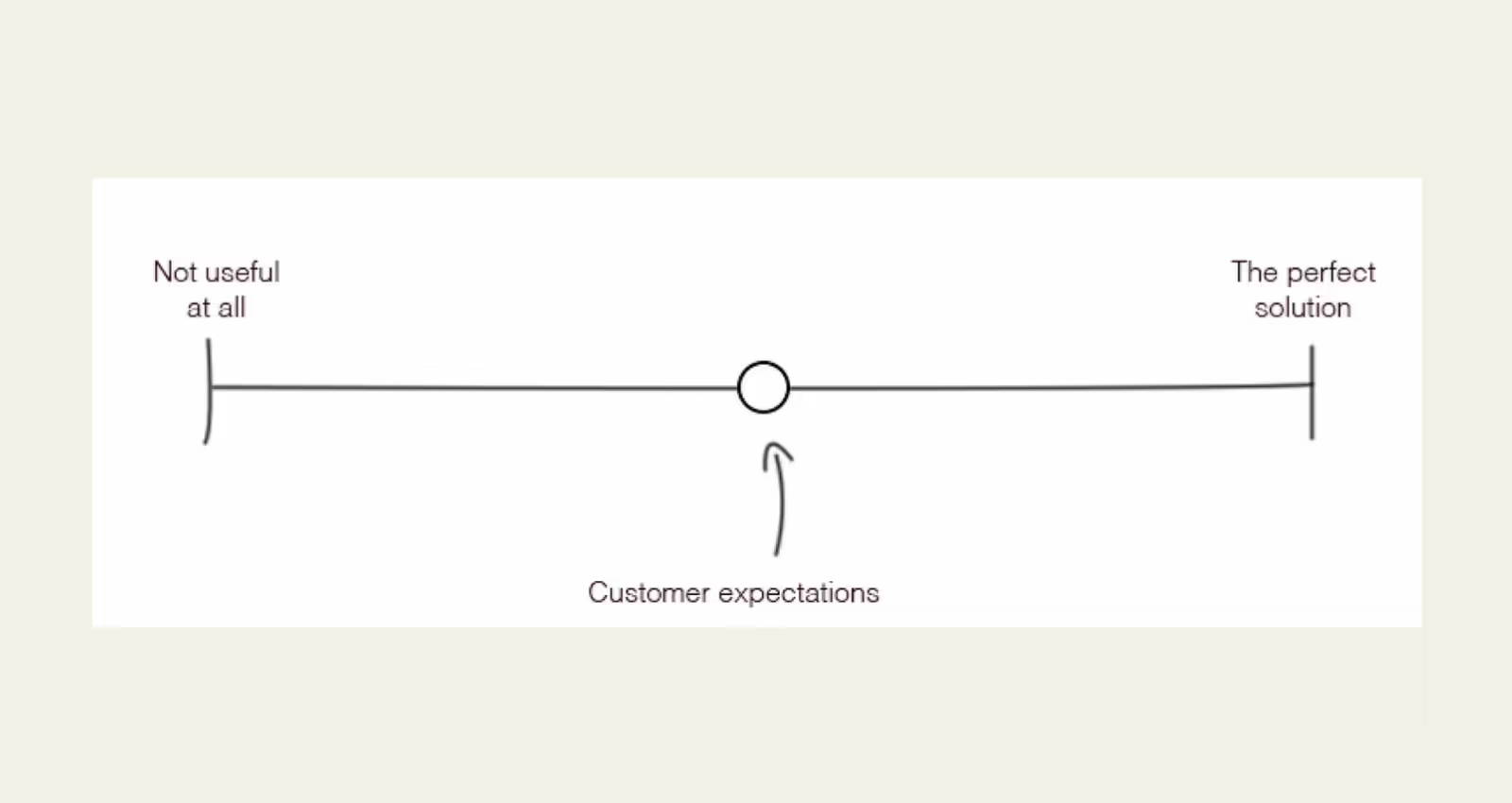Building products that people love
Building products that people love

Creating a product that your customers love is the startup holy grail.
A product that elicits a powerful emotional response will have people coming back for more, and they’ll also tell their friends. People are happy to pay for things that they love – making beloved products the foundation for exceptional businesses.
It’s not always obvious how to create that delight though. Product building necessarily requires tradeoffs, so how do you make the right tradeoffs and create something delightful? These tradeoffs are especially important for startups to make, as they’re so resource-constrained.
"Build something 100 people love, not something 1 million people kind of like."
∙ YCombinator
" "Butter” is the term we use to describe interactions and experiences that are just so smooth. Rich, easy, delicious. Hard to define formally, but you know it when you see it / feel it."
∙ USV
How we think about “product love“ 😻
At Connect, we conceptualise “product love” in three parts. Think of these as layers of a pyramid – you can’t add a layer until the previous ones are in place.
First, the table stakes
These are your ”jobs to be done”. They’re the things that customers know you for, and what they use your product to do. Whether it’s connecting them to friends, automating their workflow, or helping them book a taxi, you have to do the thing(s) that you promised.
When you do, you’ve achieved basic product-market-fit. Without this, your product can’t be loved because it doesn’t work. You might measure this through NPS, or retention, or by asking how disappointed your customers would be if they couldn’t use you any more. The exact measure doesn’t matter for now.
The point is – you need to nail the basic expectations of your customers. The graph below shows customer expectations for a hypothetical product. Anything to the right exceeds those expectations, anything to the left doesn’t meet them.

Next up is delight:
This is going above-and-beyond those table-stakes. It takes something unexpected to create an emotional response.
People laugh at a joke when they don’t expect the punchline. The scariest movies are ones where you can’t see the monster and don’t know what to expect. People share a viral video because it gave them an unexpected emotional reaction.
To have that same impact with your product, you must give your users more than they expect.
Delight isn’t about cute animations, or little jokes in your product. People often like these, but it’s not enough to drive true, deep product love. You don’t go back to a restaurant for the cartoons on the menu. You go back because the food, service, price, or ambience is better than you expect.
You have to create delight in a way that people care about, and people care about surprisingly few things. These are the things that they’ll take into account when choosing whether to use you or a competitor, and cute animations rarely come into that decision.
When ordering a taxi online, true delight doesn’t come from transition animations between screens. It comes from the taxi arriving within 5 minutes and being cheaper than you thought it would be.
Another example is Gmail letting you unsend an email, for those times when you see an error just after hitting send. People didn’t expect this ability or how it could improve their communication skills.

You can’t achieve delight without meeting the table stakes. Wise treat this like Maslow’s hierarchy of needs, saying you can only create delight once you’ve solved a real problem and solved it well. Gmail’s undo feature wouldn’t mean anything if the send/receive functionality wasn’t reliable.
Maybe it’s faster or cheaper than customers expected, like Amazon Prime. Maybe you have a mission that resonates with your customers, like Wise or Robinhood. Maybe you perform your core function better than they could imagine, like Spotify. Maybe your brand just resonates where they feel neglected, like Monzo.
This delight is the value between the value you deliver, and their expectations.
.avif)
Over time, the bar for delight increases. It increases as your competition gets better i.e. what was once delightful becomes table stakes. Websites are expected to look good on mobile and load fast and work perfectly cross-browser. These things used to be delightful differentiators but no longer are.
General technology trends can raise the bar too. As consumer apps deliver superior experiences, people start to expect the same everywhere else – across the products they use for work, travel, shopping or any other part of life.
Jonny Burch, founder of Progression gives recent AI innovations as an example: “If we don’t stay ahead of the curve, suddenly things that might have been delighters turn into missing features”.
Amazon made anything other than next-day delivery feel slow. Waiting a week for the next episode of a TV show feels laborious and pointless now we can binge-watch Netflix.
The last piece is the butter:
The idea of butter as a product experience comes from this excellent post by Nick Grossman of USV.
Even if you can’t see it, adding butter to food makes everything taste better. Butter in products makes them easier to use and generates feelings of satisfaction. This could be the difference between looking for the button to proceed and just knowing where it is. Or seamlessly knowing where you are in the process of using the product.
We can call it “usability”, but that word doesn’t do justice to the visceral reaction users have to product butter.
Butter typically takes two forms – the product speaking to you in a way that deeply resonates or making the product so easy to use that you don’t need to think.
Mariam El Beshlawi, Group PM at Wise says that good designs are discoverable and understandable. She gives the negative example of an oven: “think of every time you go to a new airbnb or visit a friend and have no idea how to turn on the super modern and slick stove top or oven”.
One of my favourite examples of empathy butter comes from Mailchimp:
.avif)
Sending a mass email to many people is terrifying. Between your content, subject line, and recipients there’s a lot that can go wrong, and you can’t recall emails. This last screen reminds you which list you’re sending to, and the amount of subscribers (so you can sanity check you’re sending the right email to the right group).
The nervous animation and empathetic text demonstrate that the product knows what you’re feeling. These are not random acts of cuteness – this screen shows that Mailchimp deeply understands you. That’s butter.
An example of “use without thinking” butter comes from Typeform, the survey creation tool. When you hit ‘Publish’ on a survey, it opens up this little modal:
.avif)
This gives you ways to share, embed, and connect with other apps as obvious next steps for your survey. They take the next step of the journey for you.
As a lovely extra touch of butter, the text for the link is already highlighted. You can either click ‘copy’, or just hit cmd+C without needing to move the mouse at all. A small touch, but it just removes that little bit of friction.
You can find many examples when you start looking for them:
- Google Calendar automatically invites someone to a meeting that you create, when you have their calendar visible.
- When Audible is interrupted by a notification sound, it goes back a few seconds so you don’t miss anything.
- The URL docs.new automatically takes you into a new Google Doc, saving you a few clicks.
- If you want to quit Chrome by hitting cmd+Q, you need to hold it down. This prevents you from accidentally closing lots of tabs.
Butter is important because it makes users more likely to get value and more likely to tell others about your app. When someone recommends a product to their friend, they spend social capital. If their friend loves the product, they get the social capital back in spades. If their friend doesn’t love it, they lose it. We’ve all got friends that will recommend something and we’ll roll our eyes, because we don’t always trust their judgement.
A product slathered with butter is more likely to be recommended and used. Less thinking, more value, more delight.
If your product hits expectations, exceeds them, and can then be slathered in butter; you’ll have product love.
.avif)
Focus to build delight 🔬
Knowing what table stakes are in your product can feel obvious – you probably understand the job customers come to you to achieve. But it’s hard for delight. What do you build when you could build anything?
The key is slimming down your focus to only the things that your customers really, really care about. List out what these are and deliver on those things to an out-of-this-world level.
Mariam El Beshlawi points out that “this requires knowing your customer deeply and understanding their problems and use cases intimately”. You can’t create delight without really getting to know your audience.
At Wise we once went through a phase of slower growth. We’d shipped a lot of the ‘basic’ product we wanted to, and had no clear and obvious ‘next’ steps. One of the senior PMs pulled together a strategy for the product – a list of things we had to be exceptional at.
He proposed:
- Speed (eventually instant)
- Price (eventually free)
- Convenience (pay how you want, on any device)
Having this shortlist gave teams the permission to focus. Rather than thinking about the next features, it gave us a clear set of problems to solve.
This led to instant transfers, cards, and Wise accounts. By focussing on speed, price, and convenience, Wise were able to exceed expectations.
Amazon does this well too. They only really care about price, selection, and speed.
The usability of their homepage is pretty horrible. It has your previously viewed items, next to things you’ve already bought, next to whatever they want to sell you, next to their version of Netflix, next to their version of Spotify.
.avif)
But they have every item you can imagine, at the lowest cost, delivered to you sometimes later that day. They nail price, selection, and speed to delight their customers.
You can’t work out how to delight your customers by looking at data. You have to speak to them.
Don’t just talk about your company, or the problem you solve. Ask what they care about, and what’s truly important to them. Once you understand that, you can build a product that they love.
AirBnB created love by imagining an “11 star experience”. They asked themselves “if money wasn’t a factor, what would the best hospitality experience ever look like?”. They spoke to customers to find out what their perfect experience was, way outside of just their app. They then realised that a lot of those dreams were pretty achievable within the app.
Brian Chesky, AirBnB founder, said “if you want to create a great product, just focus on one person. Make that one person have the most amazing experience ever”.
How can you create butter?
Butter and smooth experiences are more art and less science. There are three broad steps that you can take to make a ‘butter’ experience:
1/ Hire exceptional people.
You need people that care deeply about usability, and are willing to fight for it. Usability is often the first casualty of a high-pressure environment, so you need people that won’t compromise on it. The best way for you to create butter is to hire people that care about it.
Make sure that you hire people with impeccable taste and commercial pragmatism. Set your bar high; don’t filter out for averages. Colin Powell, former US Secretary of State, used to advise that you should “hire for strengths, rather than a lack of weaknesses”.
This obviously applies to designers, as well as (perhaps less obviously) engineers and product managers too.
2/ Create a culture where butter is expected.
Give your team the time and space to do user testing, and craft a thoughtful process. Make sure all product teams know that a fantastic and delightful user experience is expected by leadership. Create a common language where people can talk about brilliant experiences without feeling fluffy.
Mariam El Beshlawi explains that teams “often only celebrate numeric goals and milestones, it’s important to also celebrate the quality of your product”
Enzo Avigo, tells how they bake butter in at June.so:
A method we have at June is systematically include a butter in the first scope of a feature. Let’s say you’re at a scoping session, someone in the room should stand up and say “where is the delight on that feature?”. Often time it’s fine to scope down some functionality to add the cherry on top of what we’ve built.
We have a channel called #cool-product In it we mostly share stunning design. Over time it has become alsmot a game to share amazing designs. It influences the team in terms of “what stunning means” in this world.
3/ Spend deliberate time in other products.
You should be learning from all products, not just direct competitors. Spend time in travel, media, SaaS, e-commerce products. Pay attention to the experiences they’ve built, rather than just whizzing through. You’ll learn as much from brilliant experiences as you will from shoddy ones.
4/ Be clear with your principles.
Over time, product teams acting independently can create a Frankenstein product. Lots of individual features and components that optimise for their individual purpose, but together create a janky experience. This is similar to what Steven Sinofsky of Andreessen Horowitz calls “shipping the org chart”.
A strong tool to guard against this is having a clear set of principles in place when building product. These are things that you believe, that will beat data in an argument. A famous example is Google’s “don’t be evil”, which was more important than moving metrics. Define the things that you really care about, and will always care about ahead of metrics.
A quick note on bugs 🐞
Can you have a product that people love that has bugs in it?
My belief is ”absolutely, yes”. Every single mainstream product has bugs. It’s almost impossible to ship a product without them.
If you provide enough value to your customers, and exceed their expectations, then they’re often willing to accept rough edges. The major exceptions would be high-trust markets that involve families, healthcare, or money. In those instances a bug can send a worrying signal about product quality elsewhere. But for most products we encourage builders to focus on providing value, rather than eradicating bugs.
Some of our favourite examples of Product Butter 🧈
Here’s a bunch of small delighters that we’ve found on our travels around the internet.
.avif)
On Google Maps, when you click on the lat/long it is automatically copies to clipboard. Without this, writing down the lat/long would be a bit awkward. Try it.
.avif)
In Google Calendar if you have a colleague’s calendar visible and create a new event, it automatically creates a name for the meeting and invites the person.
.avif)
Superhuman’s favicon changes to show the number of unread emails that you have. It’s a great way to grab attention and communicate with users without clicking the tab.
.avif)
From a video game, but very cool: when playing Zelda on the Switch, you get button prompts. Rather than just saying “B” and leaving the user to find the button and remove themselves from the game, the icon shows you that it’s the right-hand button. This keeps you immersed and makes you feel like a pro even if you’re a noob.
.avif)
On social networks, they include a photo of you next to the reply box. This makes you feel like you’re already in the conversation, and partway through a reply. It lowers the barrier to imagining yourself replying to this comment.
.avif)
On Reddit, if you copy some text from a comment to your clipboard, then click ‘reply’ it automatically formats that text into a quote. It’s not just any text in your clipboard, only if copied directly from the comment.
.avif)
On Visual Studio Code (and many other IDEs) if your tab is fully saved, the main icon is an ‘x’ to close the tab. They alert you if you have unsaved code with a circle so that you don’t accidentally lose any code.
.avif)
It’s not software, but we love it: most keyboards have bumps on the ‘F’ and ‘J’ keys so that you can subconsciously know where your fingers are at all times. This has been the case for years, and most people don’t even notice.
.avif)
When you set an alarm on an Android phone, you get a little modal telling you how long until the alarm goes off. This is a great little confirmation and reassurance that you’ve set it for the right time.
📚 Further reading:
- The Butter Thesis by Nick Grossman, USV
- People = Product by Nilan Peiris, Wise
- The Kano Model by the Baymard Institute
- The Design of Everyday Things by Don Norman


